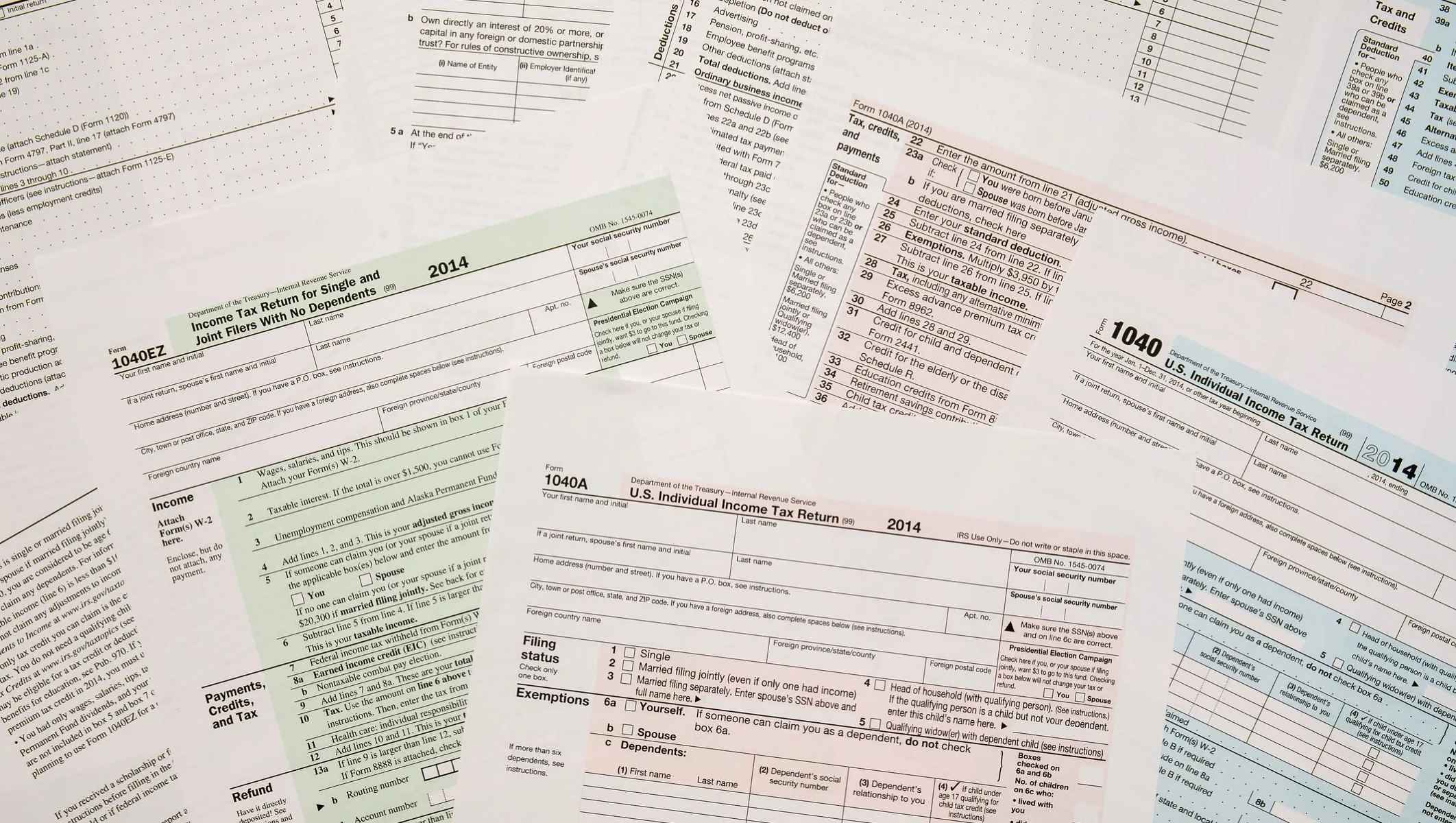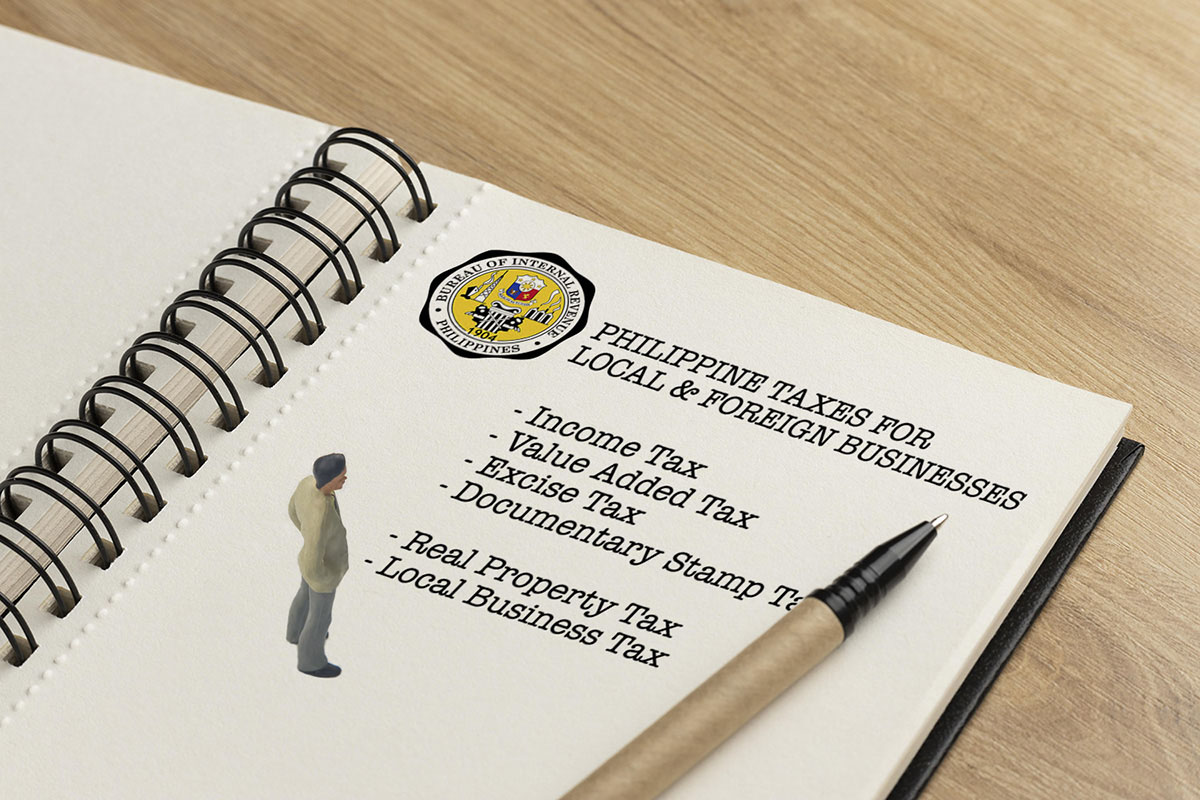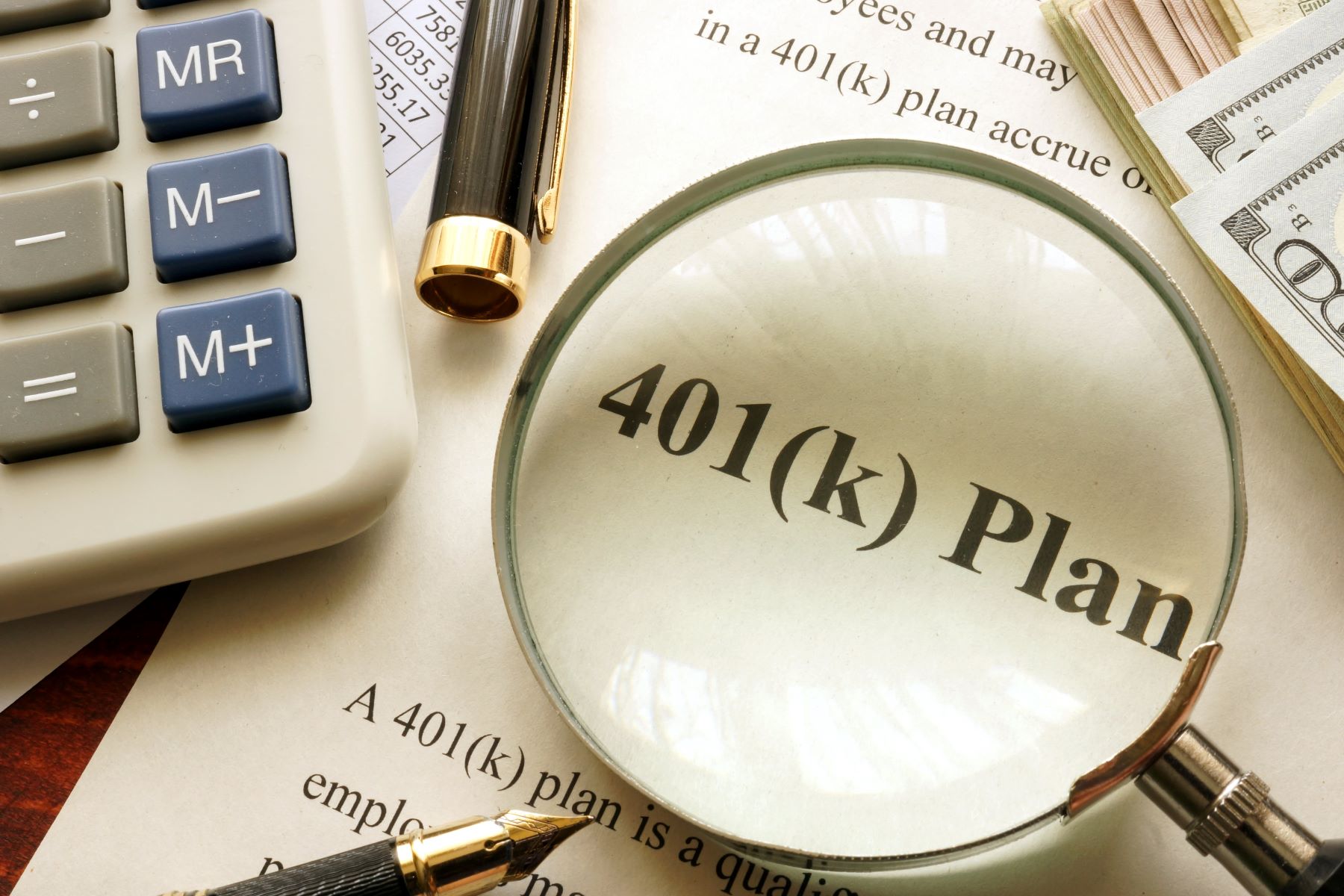

Finance
What Tax Document Do I Need For 401K
Modified: February 21, 2024
Need help determining the tax document needed for your 401K? Look no further! Our finance experts have all the answers.
(Many of the links in this article redirect to a specific reviewed product. Your purchase of these products through affiliate links helps to generate commission for LiveWell, at no extra cost. Learn more)
Table of Contents
- Introduction
- Overview of 401k
- Importance of Tax Documents for 401k
- Common Tax Documents Required for 401k
- Form 1099-R
- Form 5498
- Form 1040
- Form 8880
- Form 8606
- How to Obtain and Use These Tax Documents
- Contacting Your 401k Provider
- Online Access to Tax Documents
- Utilizing Tax Software or a Tax Professional
- Tips for Filing Taxes with 401k Documents
- Conclusion
Introduction
Welcome to the world of 401k and taxes! If you have a 401k retirement plan, you may be wondering what tax documents you need to gather when it comes time to file your taxes. Understanding the tax implications of your 401k is crucial for proper reporting and ensuring compliance with IRS regulations.
A 401k is a retirement savings account offered by employers, which allows employees to contribute a portion of their salary on a pre-tax basis, meaning the contributions are deducted from their taxable income. The funds in a 401k account grow tax-deferred until withdrawal, typically during retirement.
While the tax advantages of a 401k are well-known, it’s important to note that this tax-deferral is temporary. When you eventually withdraw funds from your 401k, they will be subject to income tax at your applicable tax rate.
Now, let’s dive into the details of tax documents you need for your 401k and why they are important.
Overview of 401k
A 401k is a popular retirement savings plan offered by employers to help employees save for their retirement. It is named after the section of the U.S. Internal Revenue Code that governs it. The primary advantage of a 401k is the opportunity to save for retirement on a tax-advantaged basis.
Here’s how it works: you contribute a portion of your pre-tax income to your 401k account, and this money is invested in a selection of funds of your choosing, such as stocks, bonds, or mutual funds. The contributions you make to your 401k are deducted from your taxable income, which means you pay less in taxes today.
One of the major advantages of a 401k is employer matching. Many employers offer a matching contribution, where they will match a certain percentage of your contributions to your retirement account. This is essentially free money, and it’s a great way to accelerate your retirement savings.
Another key benefit of a 401k is tax-deferred growth. Any investment gains within your 401k account are not subject to capital gains tax or dividend tax. This allows your investments to grow faster compared to a taxable investment account.
However, it’s important to note that there are limitations on contributions and withdrawals from a 401k. The IRS sets annual contribution limits, which can vary depending on the year and your age. Withdrawals from a 401k before the age of 59 ½ may be subject to an additional 10% early withdrawal penalty, in addition to income tax.
Now that you understand the basics of a 401k, let’s explore the importance of tax documents when it comes to managing your account and filing your taxes.
Importance of Tax Documents for 401k
Tax documents play a crucial role when it comes to managing your 401k and filing your taxes accurately. These documents provide important information about your contributions, withdrawals, and overall activity within your retirement account. Understanding and properly utilizing these tax documents is essential to ensure compliance with IRS regulations and maximize your tax benefits.
One of the primary reasons tax documents are important for your 401k is for reporting your contributions. Each year, you are required to report the amount of money you contributed to your 401k on your tax return. This information is typically included in a tax document known as Form 5498.
Furthermore, tax documents are crucial for reporting any distributions or withdrawals from your 401k. When you withdraw funds from your 401k account, you may be subject to income tax on the amount withdrawn. These withdrawals are reported on a tax document called Form 1099-R.
Additionally, tax documents provide important details about any taxable events within your 401k account. For example, if you have made after-tax contributions to your 401k, you may be eligible to claim the Retirement Savings Contributions Credit, also known as the Saver’s Credit. This credit can potentially reduce your tax liability. The necessary information to claim this credit can be found on Form 8880.
Furthermore, if you have made any non-deductible contributions to a traditional IRA and have converted them to a Roth IRA, you will need to report this conversion on Form 8606.
Properly utilizing these tax documents ensures that you accurately report your retirement account activity, claim any applicable tax credits or deductions, and avoid any potential penalties or errors on your tax return.
Now that you understand the importance of tax documents for your 401k let’s dive into the common tax documents that you will need to access and understand for effective management of your retirement account.
Common Tax Documents Required for 401k
When it comes to managing and filing taxes for your 401k, there are several common tax documents that you should be aware of. These documents provide essential information about your contributions, withdrawals, and other activities within your retirement account. Understanding these tax documents is crucial for accurate reporting and compliance with IRS regulations. Here are the common tax documents required for your 401k:
- Form 1099-R: This form is used to report distributions or withdrawals from your 401k account. It provides important information such as the amount of the distribution, any taxes withheld, and the reason for the distribution (such as retirement, disability, or early withdrawal).
- Form 5498: This form is issued by your 401k provider and reports the contributions made to your retirement account during the tax year. It includes information about your annual contributions, rollover contributions, and any contributions made on your behalf, such as employer matching contributions.
- Form 1040: This is the standard individual income tax return form used to report your overall income, deductions, and credits. Your 401k contributions and withdrawals are reported on this form, along with other income sources and deductions.
- Form 8880: This form is used to determine if you are eligible for the Retirement Savings Contributions Credit, also known as the Saver’s Credit. If you have made eligible contributions to your 401k, you can use this form to calculate the credit amount.
- Form 8606: This form is used to report any conversions or rollovers from a traditional IRA to a Roth IRA. If you have made after-tax contributions to a traditional IRA and have converted them to a Roth IRA, you will need to report this on Form 8606.
It’s important to note that while these are the common tax documents required for your 401k, your specific tax situation may require additional forms or schedules. Consulting with a tax professional or utilizing tax software can help ensure that you have all the necessary documents and that you accurately report your 401k activity on your tax return.
Next, we will discuss how to obtain and use these tax documents effectively for managing your 401k account and filing your taxes.
Form 1099-R
Form 1099-R is a tax document that reports distributions or withdrawals from your 401k account. Whenever you take a distribution from your retirement account, whether it is a regular distribution, a rollover, or an early withdrawal, the financial institution or plan administrator that holds your 401k will generate a Form 1099-R.
Form 1099-R provides important information that you will need when filing your taxes. It includes details such as the amount of the distribution, any taxes that were withheld, the reason for the distribution (such as retirement, disability, or early withdrawal), and the tax implications associated with the distribution.
When you receive your Form 1099-R, you should review it carefully to ensure the accuracy of the information. Check that your personal information, such as your name, address, and Social Security number, is correct. Verify that the distribution amount and tax withholding amount are accurate as well.
It’s important to note that different codes are used to indicate the reason for the distribution on Form 1099-R. For example, code 1 is used for distributions due to retirement, code 2 for distributions due to early withdrawal, and code 7 for normal distributions after age 59 ½. Understanding these codes can help you identify the nature of the distribution and its associated tax implications.
When it comes time to file your taxes, you will need to include the information from Form 1099-R on your tax return. The distribution amount will need to be reported as income, and any taxes that were withheld will be credited towards your overall tax liability. Depending on the nature of the distribution, you may also need to include additional forms or schedules to report any penalty exemptions or specific circumstances related to the distribution.
It’s crucial to keep your Form 1099-R in a safe place along with your other tax documents. In case of any questions or discrepancies, having this document readily available will help you resolve any issues with the IRS or your tax professional.
Now that we have covered Form 1099-R, let’s move on to the next tax document you need for your 401k: Form 5498.
Form 5498
Form 5498 is a tax document that reports the contributions made to your 401k account during the tax year. This form is generated by your 401k provider and provides important information about the contributions you made to your retirement account.
When you receive Form 5498, it’s important to review it carefully to ensure the accuracy of the information. Check that your personal details, such as your name, address, and Social Security number, are correct. Verify that the contribution amount reported on the form matches your records.
Form 5498 includes various types of contributions made to your 401k account, including:
- Employee contributions: This refers to the contributions you made from your pre-tax income. These contributions are typically deducted from your paycheck and are not included in your taxable income.
- Employer contributions: This includes any matching contributions your employer made to your 401k account. Employer contributions are a valuable benefit, as they can significantly boost your retirement savings.
- Roll-over contributions: If you have rolled over funds from another retirement account, such as an IRA or a previous employer’s 401k, these contributions will be reported on Form 5498.
It’s important to note that Form 5498 is an informational document that is sent to you and the IRS; it does not need to be attached to your tax return. However, you should keep a copy of this form for your records and provide the information from Form 5498 when filing your taxes.
When filing your taxes, you will need to report your 401k contributions on Form 1040. The contributions made to your 401k may impact your tax liability, as they can reduce your taxable income and potentially qualify you for certain tax benefits.
It’s important to keep Form 5498 in a safe place along with your other tax documents. This form serves as proof of your contributions and can be helpful in case of any questions or inquiries from the IRS or your tax professional.
Now that we have covered Form 5498, let’s move on to the next tax document you need for your 401k: Form 1040.
Form 1040
Form 1040 is the standard individual income tax return form used by taxpayers to report their overall income, deductions, and credits. When it comes to your 401k, Form 1040 is where you will report your contributions, withdrawals, and any other relevant details related to your retirement account.
When filling out Form 1040, there are specific sections where you will report your 401k activity:
- Adjusted Gross Income (AGI): This is your total income from all sources, including any taxable distributions from your 401k. You will report the taxable portion of your 401k withdrawals as income on Line 4d of Form 1040.
- Deductions: If you made contributions to a Traditional 401k, you may be eligible to deduct those contributions from your income. The deductible amount should be reported on Schedule 1, Line 19 of Form 1040.
- Saver’s Credit: If you meet certain income criteria and have made eligible contributions to your 401k, you may be eligible for the Retirement Savings Contributions Credit, also known as the Saver’s Credit. You can claim this credit on Form 8880 and report it on Form 1040, Line 12a.
When filling out Form 1040, it’s important to accurately report the information regarding your 401k activity to ensure compliance with IRS regulations. Keep in mind that depending on your specific circumstances, you may need to include additional forms or schedules to report certain aspects of your 401k, such as early withdrawal penalties or rollovers.
It’s worth noting that there are different versions of Form 1040, including Form 1040A and Form 1040EZ. However, as of the 2018 tax year, the IRS has consolidated these forms into the new Form 1040. The new Form 1040 aims to streamline the tax filing process and, in most cases, will cover the reporting requirements for your 401k.
As always, it’s recommended to consult with a tax professional or utilize tax software to ensure that you accurately complete Form 1040 and report your 401k activity correctly.
Now that we have covered Form 1040, let’s move on to the next tax document you need for your 401k: Form 8880.
Form 8880
Form 8880, also known as the Retirement Savings Contributions Credit, is a tax form used to determine if you are eligible for a tax credit based on your contributions to a retirement savings account, including a 401k. This credit, commonly referred to as the Saver’s Credit, can help lower your tax liability and provide additional incentives for saving for retirement.
Form 8880 allows you to calculate the amount of the credit based on your contributions to your 401k. The credit is based on a percentage of your eligible contributions, ranging from 10% to 50%, depending on your income level and filing status.
To be eligible for the Saver’s Credit, you must meet the following criteria:
- Be at least 18 years old
- Not be a full-time student
- Not be claimed as a dependent on someone else’s tax return
When completing Form 8880, you will need to provide information about your contributions to your retirement account, such as your 401k. If you have made eligible contributions to your 401k, you can then calculate the credit amount using the provided instructions on the form.
It’s important to note that the Saver’s Credit is a non-refundable credit, which means it can reduce your tax liability but cannot result in a tax refund. However, it is still a valuable incentive to encourage retirement savings and can help lower your overall tax bill.
When filing your taxes, you will report the Saver’s Credit on Form 1040. The credit amount is entered on Line 12a, and you will check the appropriate box to indicate that you are claiming the Retirement Savings Contributions Credit.
Be sure to keep a copy of Form 8880, along with your other tax documents, for your records. If the IRS requests any additional information or audits your tax return, having this form readily available will help support your claim for the Saver’s Credit.
Now that we have covered Form 8880, let’s move on to the next tax document you need for your 401k: Form 8606.
Form 8606
Form 8606 is a tax form used to report certain non-deductible contributions to traditional IRAs and to track the tax basis in your IRA accounts. While Form 8606 is primarily associated with IRAs, it may also be relevant for individuals who have made after-tax contributions to a traditional IRA and subsequently converted those funds to a Roth IRA.
If you have made after-tax contributions to a traditional IRA and have converted those funds to a Roth IRA, Form 8606 is used to report and track the taxable portion of the conversion. It helps you keep a record of the contributions that have already been taxed, as any qualified distributions from a Roth IRA are tax-free. It also ensures that you don’t get taxed twice on the same funds.
When completing Form 8606, you will provide information about the nondeductible contributions you made to your traditional IRA, including the year and the amount of each contribution. You will also report the amount of any distributions or conversions you made from your traditional IRA to a Roth IRA.
Form 8606 serves two main purposes:
- It establishes the basis of your IRA accounts: By filling out Form 8606, you allocate after-tax contributions to create the basis of your traditional IRA account. This basis is important when determining the taxable portion of any future distributions or conversions.
- It calculates the taxable amount of a conversion from traditional to Roth IRA: If you convert funds from a traditional IRA to a Roth IRA, Form 8606 helps determine the taxable portion of the conversion. This is based on the ratio of after-tax contributions to the total value of your traditional IRA accounts.
It’s important to consult with a tax professional or utilize tax software when completing Form 8606, as the calculations can be complex and depend on various factors, such as previous non-deductible contributions and conversions.
Once completed, keep a copy of Form 8606 for your records, as it provides documentation of the basis in your IRA accounts and can help you accurately report future distributions and conversions.
Now that we have covered the common tax documents required for your 401k, you have a comprehensive understanding of the importance of tax documents, how to obtain them, and how to use them effectively when managing your retirement account and filing your taxes.
Remember, keeping accurate records of your 401k activity and consulting with a tax professional or utilizing tax software will ensure that you navigate the tax process smoothly and maximize your tax benefits.
How to Obtain and Use These Tax Documents
Obtaining and using the necessary tax documents for your 401k is essential for effectively managing your retirement account and filing your taxes accurately. Here are three common methods to obtain and utilize these tax documents:
- Contacting Your 401k Provider: The first step is to reach out to your 401k provider directly. They will provide you with the necessary tax documents for your account. Reach out to their customer service team via phone or email and request the specific forms you need, such as Form 1099-R, Form 5498, or Form 8880. Be sure to provide your account details and any other necessary information to expedite the process.
- Online Access to Tax Documents: Many 401k providers offer online account access where you can view and download your tax documents. Log in to your 401k account through the provider’s website or mobile app to access your documents. Look for a section specifically dedicated to tax documents or statements. Download the relevant forms, such as Form 1099-R or Form 5498, and save them for your records or print them out for reference.
- Utilizing Tax Software or a Tax Professional: Another option is to use tax software or consult with a tax professional. Tax software programs, such as TurboTax or H&R Block, can help you navigate through the tax filing process and guide you on which tax documents are needed for your 401k. These software programs often have features that import data from your financial institutions, making it easier to obtain and use the relevant tax documents. Alternatively, you can seek the assistance of a tax professional who can help ensure that you have all the necessary tax documents and accurately report your 401k activity on your tax return.
Once you obtain the required tax documents for your 401k, carefully review them to ensure the accuracy of the information provided. Double-check your personal details, contribution amounts, withdrawal information, and any applicable tax credits or deductions.
When using these tax documents, it’s important to follow the instructions provided on each form. Report the relevant information on the appropriate sections of your tax return, such as Form 1040 or Schedule 1. Be sure to include any additional forms or schedules that may be required to report specific aspects of your 401k, such as Form 8880 for the Saver’s Credit or Form 8606 for after-tax contributions and conversions.
Keeping copies of these tax documents, along with your other tax records, is essential for future reference and potential audits. Store them in a safe and easily accessible place, such as a secure folder or a digital file, for easy retrieval when needed.
By utilizing these methods to obtain and effectively use the necessary tax documents for your 401k, you can navigate the tax filing process with confidence and ensure accurate reporting of your retirement account activity.
Now that you are equipped with the knowledge of obtaining and using these tax documents, you can confidently approach your 401k tax filing with ease and efficiency.
Contacting Your 401k Provider
One of the most straightforward methods to obtain the necessary tax documents for your 401k is to contact your 401k provider directly. Your 401k provider is responsible for managing your retirement account and should be able to provide you with the required tax documents upon request.
To initiate the process, reach out to the customer service department of your 401k provider. Contact information can typically be found on their website or on your account statements. You can either call their customer service hotline or send an email to request the specific tax documents you need, such as Form 1099-R or Form 5498.
Make sure to provide your account details, including your account number and personal information, to assist the customer service representative in retrieving the relevant tax documents for your specific situation. They may also request additional identifying information to ensure the security of your account.
Once you have reached out to your 401k provider, they will typically generate and send the requested tax documents to you either via mail or electronically, depending on your preference and their available delivery methods. The delivery process may take a few days to a couple of weeks, so it’s important to initiate the request well in advance of your tax filing deadline.
Upon receiving the tax documents, carefully review them to ensure that all the information is accurate. Check important details such as your personal information, contribution amounts, and any distributions or withdrawals made from your 401k account.
If you notice any discrepancies or have any questions regarding the tax documents you have received, don’t hesitate to contact your 401k provider again for clarification or assistance. They should be able to address any concerns and provide further guidance to ensure your understanding and accurate tax reporting.
By contacting your 401k provider directly, you can efficiently obtain the necessary tax documents for your retirement account and proceed with filing your taxes accurately. Keep copies of these documents for your records, as they serve as important documentation of your 401k activity and can be useful in the event of any future inquiries or audits.
Now that you understand how to contact your 401k provider for tax documents, let’s explore another method of obtaining these documents: Online Access to Tax Documents.
Online Access to Tax Documents
Many 401k providers offer convenient online access to tax documents, making it easy for account holders to obtain the necessary forms for tax filing. Online access provides a quick and efficient way to retrieve your tax documents without the need to contact your 401k provider directly or wait for documents to arrive by mail.
To access your tax documents online, you will typically need to log in to your 401k account through the provider’s website or mobile app. If you haven’t already set up an online account, follow the registration process outlined on the provider’s website. This usually involves verifying your identity and creating login credentials.
Once you’re logged in to your account, navigate to the section dedicated to tax documents or statements. The exact location of this section may vary depending on the provider’s website layout, but it is typically labeled as “Tax Documents,” “Statements,” or a similar term.
Within the tax documents section, you will find a list of the different tax forms available for your account. This may include forms such as Form 1099-R, Form 5498, or Form 8880, depending on your specific tax situation and the available options provided by your 401k provider.
Select the desired tax form and download it to your computer or device. Some providers may also offer the option to have the form emailed to you or mailed as a physical copy upon request. Choose the method that is most convenient for you.
Once downloaded, review the tax form to ensure that all the information is accurate, including your personal details, contribution amounts, and any distributions or rollovers that have taken place within your account.
Save a copy of the downloaded tax form for your records. It’s recommended to create a dedicated folder on your computer or store the document securely in a cloud storage service. Having a digital copy ensures that you have easy access to your tax documents whenever you need them.
Online access to tax documents also allows you to retrieve previous years’ forms, which can be helpful for reference or if you need to amend a prior tax return. Check with your 401k provider to determine the availability of past tax documents through their online portal.
By utilizing online access to tax documents, you can conveniently retrieve the required forms for your 401k account, review the information, and securely store digital copies for future reference. Now that you understand how to access tax forms online, let’s move on to the next method of obtaining and using these documents: Utilizing Tax Software or a Tax Professional.
Utilizing Tax Software or a Tax Professional
If you prefer a more guided approach to obtaining and using your 401k tax documents, utilizing tax software or seeking assistance from a tax professional can be beneficial. These options provide expert guidance and ensure that you accurately report your 401k activity on your tax return.
Tax software programs, such as TurboTax, H&R Block, or TaxAct, are designed to simplify the tax filing process. They offer step-by-step instructions and intuitive interfaces that walk you through the necessary steps to file your taxes accurately.
To use tax software, you typically purchase or subscribe to the program and follow the prompts to input your personal information and tax details. Once you’ve set up your account, the software will guide you in answering questions and inputting the necessary information about your 401k contributions, withdrawals, and any other relevant details.
As you progress through the software, it will prompt you to enter your tax documents, such as Form 1099-R or Form 5498, by either manually inputting the information or uploading electronic copies of the documents. The software will use the provided information to calculate your tax liability and ensure that you claim any eligible deductions, credits, or exemptions related to your 401k.
Alternatively, you may choose to enlist the assistance of a tax professional. A tax professional, such as a certified public accountant (CPA) or an enrolled agent (EA), is trained in tax law and can provide personalized guidance regarding your 401k tax documents.
A tax professional can help you navigate the complexities of your specific tax situation, especially if you have multiple sources of income, complex deductions, or unique circumstances related to your 401k. They can ensure that you accurately report your 401k contributions, withdrawals, and any other necessary information in accordance with IRS regulations.
By working with tax software or a tax professional, you can have peace of mind that your 401k tax documents are being handled accurately and that you maximize your tax benefits. Whether you choose tax software or a tax professional depends on your comfort level, complexity of your tax situation, and personal preference.
It’s important to gather all your relevant tax documents, including the forms specific to your 401k, before utilizing tax software or visiting a tax professional. Ensure that you have retrieved your Form 1099-R, Form 5498, Form 8880, and any other pertinent tax documents related to your retirement account.
By utilizing tax software or seeking assistance from a tax professional, you can feel confident that your 401k tax documents are being handled accurately and that you are maximizing your tax benefits. Now that you understand how to utilize tax software or a tax professional, you are equipped to efficiently complete your tax filing with the necessary 401k documentation.
Tips for Filing Taxes with 401k Documents
Filing taxes can be a complex process, especially when it comes to incorporating your 401k documents into your tax return. To ensure accuracy and maximize your tax benefits, here are some helpful tips for filing taxes with your 401k documents:
- Organize Your Documents: Keep your 401k documents, such as Form 1099-R, Form 5498, and any other relevant forms, in a designated folder. This helps you stay organized and ensures that you have all the necessary information readily available when filing your taxes.
- Review Your Documents Carefully: Review your 401k documents to verify that all the information is accurate. Check your personal details, contribution amounts, and any reported distributions or rollovers. If you notice any discrepancies, contact your 401k provider to address the issue before filing your taxes.
- Understand Tax Codes: Familiarize yourself with the tax codes associated with your 401k activity, such as the different codes used on Form 1099-R to indicate the reason for a distribution. Understanding these codes helps you better interpret your tax documents and ensures accurate reporting on your tax return.
- Report Contributions Correctly: Report your 401k contributions accurately on your tax return. If you have a traditional 401k, ensure that you report any deductible contributions on Schedule 1 of Form 1040. For an after-tax or Roth 401k, report your contributions but be aware that they are not deductible.
- Know Penalties and Exceptions: Understand the penalties and exceptions associated with 401k withdrawals. Early withdrawals before the age of 59 ½ may incur a 10% early withdrawal penalty in addition to income tax. However, certain exceptions, such as hardship withdrawals or qualified distributions, may exempt you from the penalty.
- Claim the Saver’s Credit: If you meet the income requirements and have made eligible contributions to your 401k, consider claiming the Retirement Savings Contributions Credit, also known as the Saver’s Credit. This credit can reduce your tax liability and provide additional rewards for saving for retirement.
- Seek Professional Assistance if Needed: If you have a complex tax situation or are unsure about how to handle your 401k documents, don’t hesitate to seek assistance from a tax professional. A tax professional can provide personalized guidance and ensure that you accurately report your 401k activity on your tax return.
Remember, accurate reporting and understanding the implications of your 401k activity are crucial for tax compliance. Take the time to review your 401k documents, follow the instructions provided, and take advantage of available tax benefits associated with your retirement account.
By following these tips, you can confidently file your taxes with your 401k documents and ensure that you are maximizing your tax benefits while maintaining compliance with IRS regulations.
Now that you have these tips in mind, you are well-prepared to file your taxes with your 401k documents and navigate the tax-filing process smoothly and effectively.
Conclusion
Filing taxes with your 401k documents can seem overwhelming, but with careful organization and understanding of the necessary tax forms, you can navigate this process effectively. The importance of these tax documents cannot be overstated, as they provide essential information for accurately reporting your contributions, distributions, and other activities within your 401k.
In this article, we covered the common tax documents required for your 401k, including Form 1099-R, Form 5498, Form 1040, Form 8880, and Form 8606. We also discussed how to obtain these tax documents by contacting your 401k provider, utilizing online access, or seeking assistance from tax software or a tax professional.
Furthermore, we provided tips to help you file your taxes effectively with your 401k documents. These tips include organizing your documents, reviewing them carefully, understanding tax codes and penalties, reporting your contributions correctly, and considering eligible tax credits such as the Saver’s Credit.
Remember, it’s crucial to stay organized, review your documents for accuracy, and seek professional assistance if needed. By following these steps, you can ensure that you accurately report your 401k activity, maximize your tax benefits, and maintain compliance with IRS regulations.
As tax laws and regulations may change over time, it’s important to stay informed and consult with a tax professional or utilize up-to-date tax software to ensure the accuracy of your tax filings. The expertise of professionals and the availability of user-friendly tax software can simplify the process and provide peace of mind.
By effectively managing your 401k tax documents, you are taking a significant step towards securing your financial future and maximizing your retirement savings. Remember, the more knowledge you have about your 401k and its tax implications, the better equipped you are to make informed decisions and achieve your long-term financial goals.
Now, armed with a solid understanding of the importance of tax documents, how to obtain them, and tips for filing taxes with your 401k, you can confidently navigate the tax filing process and ensure that your retirement savings are being handled accurately and efficiently.














